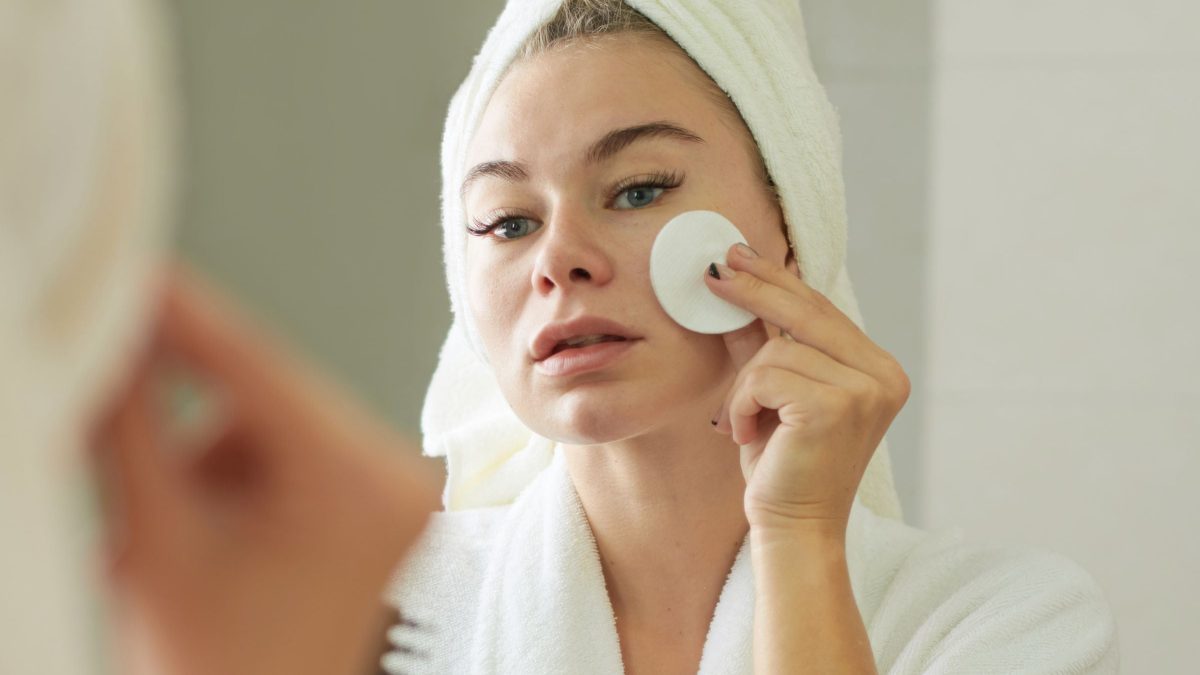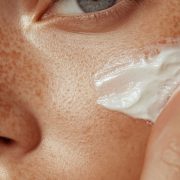Mastering Your Skin’s pH for Autumn Radiance
Posted on October 13, 2024 Written by: 100% PURE®

When the seasons change from summer to fall, we’re eager to swap out our wardrobes – bathing suits for body suits – and home comforts – breathable bedding for cozy, cloud-like bedding, but what about our skin? While we bundle up in cozy layers of clothing and bedding for autumn, our skincare often gets left out in the cold.
The cool, dry air of the fall can strip the skin of its natural protective barrier that helps to retain moisture and protect against environmental stressors. It’s like sleeping with no cozy covers, leaving your body uncomfortable and cold. Skin without its protective cover also suffers, causing the skin’s pH to become unbalanced and unhealthy, underscoring the importance of protecting it and adjusting our skin routines.
Just like we modify our clothes and bedding to match the fall weather, we need to adjust to the changing needs and seasonal shift of our skin to it hydrated and glowing all year long. Discover what works best for maintaining healthy skin through pH balance and a fall-ready skincare routine. It’s time for autumn to bring you creature comforts – and seasonal skincare success!
Decoding Skin pH
Skin pH may be shrouded in a cloud of mystery where you could associate it with a pH-deodorant ad or literally an old chemistry class. Remember dipping those color-changing strips into liquids to see where they fell on a pH scale from 1 to 14? Skin also has a pH and it’s easier to decode than, well, chemistry class!
Before we dip into the details about what skin pH is and the ideal pH range for healthy skin, we need to cover more on the skin barrier and the role of the acid mantle. The protective barrier is the outermost layer of the skin, called the stratum corneum, which acts as a barrier against external stressors. The acid mantle is a slightly acidic film on the surface of the skin, created by the natural oils and sweat. It plays a vital role in protecting against bacteria, pollutants, and moisture loss by maintaining a low pH level; essentially, the acid mantle is a key component of the skin barrier function.
Let’s get back to the “skin chemistry” class in progress. In case you need a refresher, the term ‘pH’ means ‘potential of hydrogen.’ In other words, it is the measure of the concentration of hydrogen ions in any substance. On the pH scale, anything below 7 is acidic, while anything above 7 is alkaline. It turns out that learning about those acids and bases has a lot more to do with skincare than with matter and energy.
For this mini-lesson of skin-istry, healthy skin typically has a slightly acidic pH of around 5.5. This slight acidity is essential for maintaining the skin’s natural barrier, which is crucial for keeping your skin looking and feeling its best. When the pH level is balanced, the acid mantle can function optimally, keeping your skin safe from harmful elements and locking in moisture.
However, when the pH level is disrupted, it can lead to a host of skin issues. An imbalanced pH can make the skin more susceptible to irritation, dryness, and even acne. For instance, if the skin becomes too alkaline, it can lose its moisture, leading to dryness and sensitivity. On the other hand, if it becomes too acidic, it can cause inflammation and breakouts. Maintaining the right pH balance is, therefore, essential for a healthy, glowing complexion.
So, what factors can affect your skin’s pH balance? We’re guessing you don’t have litmus paper, pH strips, and a lab within your reach. So, the next and actual best thing is to grab some copy paper and take notes. From the cleansers we use to our diet and lifestyle choices and even the environmental influences we encounter, each factor plays a critical role in influencing our skin’s delicate balance.
Skincare Products and Routines:
In the quest for flawless skin, many of us turn to a variety of cleansers and skincare products. However, not all products are created equal when it comes to maintaining the delicate balance of our skin’s pH. Harsh soaps, toxic ingredients, and high-pH skincare products can strip the skin of its natural oils, leading to dryness, irritation, and an imbalanced pH level. When the skin’s pH is disrupted, its protective barrier weakens, making it more susceptible to environmental stressors and bacteria. Opting for gentle, pH-balanced products and maintaining a consistent morning and nighttime skincare routine helps preserve the skin’s natural defenses, keeping it healthy and resilient.
Diet and Lifestyle:
Our skin’s pH is not only influenced by what we apply to it but also by what we put into our bodies and how we live our lives. Diet plays a crucial role in skin health; consuming a diet high in processed foods, sugar, and unhealthy fats can lead to an imbalance in skin pH. Additionally, stress, lack of sleep, and exercise can trigger hormonal changes that affect skin pH, leading to breakouts and other skin issues. Environmental factors, such as pollution and exposure to UV rays, can also disrupt the skin’s natural balance. By adopting a balanced diet, managing stress, and maintaining healthy lifestyle habits, we can protect our skin from environmental damage and create a harmonious skin pH balance.
Environmental Influences:
Environmental factors can affect the skin’s pH balance. For instance, the quality of the water we use daily can significantly impact our skin’s delicate balance. Hard water, which contains high levels of minerals like calcium and magnesium, can leave a residue on the skin that interferes with its natural pH. This residue can clog pores and lead to dryness and irritation. Similarly, chlorinated water, often found in swimming pools and tap water, can strip the skin of its natural oils and disrupt its pH balance. To combat these effects, using a water softener or a gentle, pH-balanced cleanser can help maintain the skin’s natural harmony.
Understanding and managing the factors that affect skin pH is crucial for maintaining a healthy complexion. By choosing the right skincare products, adopting a balanced diet and healthy habits, and being mindful of environmental influences like water quality, we can support our skin’s natural defenses and enjoy healthier, more resilient skin.

Fall’s Impact on Skin pH
Spoiler alert: your skincare routine that’s been signed, sealed, and delivered isn’t a year-round deal. As the sender, let’s just say Mother Nature has a lot to do with that. Just like this queen of weather-appointed fall to prompt you to switch out your wardrobes each season, you should change your skincare routine to match to better protect your skin’s pH against autumn elements.
Fall, with its unique climatic conditions, can have a profound impact on our skin’s pH. As the mercury drops and dryer air prevails, the moisture in our skin also decreases with an increase in sensitivities. Let’s explore how autumn and associated lifestyle changes can affect our skin health.
Temperature changes and skin reactions:
As temperatures drop in fall, the primary impact on skin pH is a tendency towards dryness due to lower humidity levels, which can disrupt the skin’s natural barrier and potentially alter its pH balance, leading to irritation, flakiness, and increased sensitivity, especially for those with pre-existing conditions like eczema or rosacea where symptoms could worsen; this is primarily caused by the skin losing moisture more rapidly in drier air.
Humidity fluctuations and their effects:
As autumn arrives, your skin faces unique challenges. Humidity levels tend to drop in the fall as outdoor temperatures cool down. The drop in humidity levels means less moisture in the air, leading to drier, tighter skin. These temperature fluctuations between chilly mornings and warmer afternoons can make your skin more sensitive, causing redness and irritation, as well as aggravating existing skin conditions. This is especially true if you’re prone to eczema or other dry skin conditions.
Increased dryness and sensitivity:
One of the most significant challenges during fall is the harsh combination of dry air and cooler weather. This duo can be particularly unkind to our skin, especially its ph balance. Cooler temperatures and lower humidity levels in the fall cause the air to dry out, which can strip moisture from your skin. This loss of moisture often leads to dryness, a feeling of tightness, and sometimes even flaking. The skin’s pH and barrier function can be compromised, making it more vulnerable to moisture loss and skin sensitivities.
Potential for breakouts and irritation:
As the skin loses moisture, it can become more than just uncomfortably dry; it can get irritated and inflamed. People with existing skin conditions like eczema or psoriasis might notice a worsening of their symptoms, while those with acne-prone skin might experience breakouts and acne. This is due to an imbalance of the skin’s pH.
When your skin’s natural pH is too alkaline, it can cause bacteria to overgrow and clog the oil glands on your face, causing acne on your otherwise perfect complexion. Acne is caused by a combination of factors, including blocked skin pores from dirt and excessive sebum production; this is something that affects all skin types. But since alkaline skin has a low acidity level, it can be especially prone to blocked pores due to excess grease – which encourages acne-causing bacteria and inflammation.
To help combat fall’s impact on skin pH, it’s crucial to adapt skincare routines that focus more on hydration and barrier repair. This means opting for pH-balancing skincare products, and taking protective measures against fall weather on your skin. So, we’re not leaving any leaves unturned, incorporating a healthy diet and lifestyle habits will also create pH balance and skin Zen.
The pH-Balancing Solution: Fall Skincare Strategies
Oh, my gourd-ness, it’s autumn! Maintaining and restoring your skin’s pH balance during fall is essential for a healthy complexion. Here are some fall-proof tips and strategies to help you achieve optimal skin health and balance:
Choosing pH-balanced cleansers:
A pH-balanced cleanser is the cornerstone of any skincare routine. It gently cleanses without disrupting the skin’s natural pH, ensuring that your skin remains balanced and healthy.
Benefits:
Gently cleanses
Maintains natural pH balance
Incorporating pH-adjusting toners:
A pH-balancing toner plays a crucial role in restoring and maintaining your skin’s pH balance. Choose a pH-adjusting toner that not only balances your skin’s pH but also provides a refreshing boost of hydration. Toners also prepare your skin to better absorb subsequent products, enhancing their effectiveness.
Benefits:
Restores pH balance
Hydrates the skin
Moisturizers that support optimal pH:
A good moisturizer is essential for maintaining hydration and pH balance. That doesn’t mean you should bring in the ultra-rich heavyweights just yet – save those for Snowmageddon (winter)! Go for more gentle, emollient products that’ll support optimal pH and combat the conditions of fall more effectively.
Benefits:
Maintains skin hydration
Supports pH balance
Protective measures against fall weather:
Incorporating serums into your routine can provide targeted treatment for specific skin concerns, such as brightening, lightening or balancing skin. Opt for a pH-supportive serum that helps target your specific skin issue and supports a healthy pH balance.
Exfoliating your face is another protective measure to help combat against fall weather. Exfoliation is key to removing dead skin cells, promoting cell turnover, and ensuring that your skin’s pH remains balanced.
Maintaining a consistent skincare routine is another measure for protecting your skin against autumn’s angst. While you’re at the sink, be sure to avoid over-washing your face. This can strip your skin of natural oils, leading to a disrupted pH balance. To maintain healthy skin, cleanse your face twice daily and after heavy sweating. This routine helps to remove impurities and excess oil without over-stripping your skin, maintaining its natural pH balance.
Diet and lifestyle tips for pH balance:
What you eat significantly impacts your skin’s pH balance. A diet rich in fruits, vegetables, and healthy fats provides your skin with the necessary nutrients to stay healthy and balanced. Antioxidant-rich fruits and vegetables can help neutralize free radicals, which can disrupt your skin’s pH. Healthy fats, such as those found in avocados, nuts, and fish, support your skin’s lipid barrier, maintaining its integrity and natural pH level. By incorporating these foods into your daily diet, you can promote a glowing, balanced complexion.
Your lifestyle can also affect your skin’s pH balance, especially if it’s full of stressors. Managing stress is crucial for maintaining a healthy skin pH. Engaging in stress-reducing activities like yoga, meditation, and regular exercise can help keep your stress levels in check, which in turn, supports your skin’s health. These activities not only help to reduce the production of stress hormones that can negatively impact your skin but also promote overall well-being. Make time for these practices in your daily routine to keep your mind calm and your skin balanced.
Achieving pH-Balanced Skin in Autumn
When the pH of the skin is balanced, the skin is healthy and moisturized. The skin’s barrier functions normally to protect the skin from free radicals and external irritants. We know that having a pH-balanced skincare routine, eating healthy, choosing healthy lifestyle habits are all crucial during the fall for overall skin health and optimal pH. When you achieve a harmonious balance, the skin-efits are nothing short of apple-solutely impressive.
Benefits of maintaining proper skin pH:
Maintaining a proper skin pH is important for a variety of factors. Your skin’s protective barrier and acid mantle stay balanced and healthy, protecting against pathogens and infections. A balanced pH helps the skin retain moisture, which protects it from dryness, dehydration, and sensitivities. A healthy pH allows beneficial bacteria to thrive on the skin, which helps protect the skin and its and promotes overall health.
Improved skin barrier function:
A healthy, balanced skin barrier protects your skin, regulates water loss from the inside out, retains moisture, and keeps you hydrated. An optimal barrier protects against irritants, pollution, UV rays, and other environmental factors. A well-functioning skin barrier helps your skin retain water, keeping it supple and hydrated. When your dermis is well-moisturized, your skin appears plumper, which can help counteract signs of premature aging. Keeping your skin’s pH at a healthy level may help protect you from skin conditions like acne, dermatitis, and eczema.
Enhanced efficacy of other skincare products:
A healthy skin barrier enhances the efficacy of other skincare products by allowing them to penetrate deeper into the skin and deliver their active ingredients more effectively, resulting in better absorption and improved visible results from treatments like serums, retinoids, and antioxidants, as a compromised barrier can hinder their full potential due to poor penetration. Your skincare products will also work best when the skin’s pH is balanced.
Consequences of Ignoring Skin pH in Fall
When skin pH is disrupted or ignored, it can lead to a host of skin issues. The consequences of an imbalanced pH can make the skin more susceptible to irritation, dryness, and even acne. If the skin becomes too alkaline, it can lose its moisture, leading to dryness and sensitivity. On the other hand, if it becomes too acidic, it can cause inflammation and acne. Additional consequences of ignoring the skin pH in autumn include:
Increased susceptibility to environmental damage:
A damaged skin barrier makes the skin more susceptible to environmental damage. The skin’s barrier protects the body from harmful irritants and external aggressors like pollution, UV, and bacteria. When the skin barrier is damaged, it’s easier for external irritants to affect its delicate balance, and it disrupts the skin’s barrier function. Signs of a damaged skin barrier include redness, irritation, sensitivity, and worsening of existing skin conditions.
Exacerbation of existing skin conditions:
A damaged skin barrier from ignoring skin’s pH during the fall can make existing skin conditions worse. If you already have eczema or psoriasis, a damaged skin barrier can make symptoms worse. A damaged skin barrier makes it harder for skin to retain water, which can lead to chronic dry, itchy skin and increased skin sensitivities. A damaged skin barrier can worsen existing acne and trigger new breakouts. This is because a compromised barrier disrupts the natural skin flora, leading to an overgrowth of acne-causing bacteria.
Accelerated signs of aging:
A damaged skin barrier from environmental factors, improper skincare or not paying attention to the skin’s pH balance during autumn can cause the skin to lose moisture, leading to dryness and dehydration. A weakened skin barrier can cause the skin to lose elasticity and firmness, resulting in wrinkles and fine lines. Parched or dehydrated skin exasperates the appearance of fine lines and wrinkles.

100% PURE pH-Friendly Fall Products
When your skin’s pH balance is off, it’s all too easy to (quite literally) feel ‘off’ or uncomfortable in your own skin. Luckily, there are ways to help your skin’s pH balance – and it starts with using pH-friendly skincare. The pie’s the limit with these fall skin gems – you might just lose your gourd over them!
This soothing, skin-softening powder cleanser calms and nurtures the skin’s natural balance. It gently washes away makeup, sunblock, and environmental impurities without stripping your skin’s protective barrier. This nourishing cleanser is made with beta glucan-rich colloidal oatmeal; soothing rose petals; deeply purifying lavender; moisturizing coconut milk; restorative echinacea and anti-inflammatory botanicals like chrysanthemum, calendula, and chamomile.
Amazing for lightweight, buildable hydration, this milk hydrator is excellent for all types of skin. As the primary ingredient, rose hydrosol acts as a moisturizing and hydrating element. It helps fight redness and irritation after application. Amazing for brightening as well, this hydrating milk is perfect for recovering blemished skin.
This cream harnesses the power of green tea’s EGCG to soothe inflammation, unclog pores, and promote healthier skin. Green tea contains EGCG, which helps combat free radicals that accelerate skin aging. EGCG promotes collagen synthesis and skin rejuvenation, leading to firmer, smoother, and more youthful-looking skin.
This super serum supports microbiome health with antioxidants and more! Using ingredients like hyaluronic acid is the most effective way to replenish skin from within for longer-lasting suppleness and hydration. Chia gel water, sea kelp, and algae also aid in water absorption with their gelatinous texture, and reduces inflammation and detoxifies the skin without disrupting the skin’s protective barrier.
This potent night serum is a synergy of stabilized vitamins designed to reduce the appearance of fine lines and wrinkles, while firming, brightening, and evening out skin tone. What sets it apart is the unique formulation of niacinamide and vitamin C — two celebrated anti-aging ingredients. While they’re usually not combined due to differing pH levels, this serum uses magnesium ascorbyl phosphate. This high-quality form of vitamin C has a pH of 6, which is identical to niacinamide. This harmony allows the two vitamins to work cohesively, ensuring a youthful and glowing complexion.
Your Path to pH-Balanced Autumn Skin
Recap of key points about skin pH and fall skincare
The transition between seasons doesn’t just influence our wardrobe or bedding choices, but it also has a significant impact on our skin. As we move into fall, the climate shifts to cooler temperatures, reduced humidity, and crisper air. These environmental changes can make the skin more prone to dryness, sensitivity, and sometimes even lead to conditions like eczema or seasonal breakouts. This loss of moisture can weaken the skin’s barrier function, making it more susceptible to external irritants, allergens, and pollutants.
Without the right care during autumn, our skin might become increasingly sensitive, dry, and more prone to redness or irritation. Therefore, adapting a pH-balanced skincare routine is essential to address these new challenges. Opt for a hydrating, non-stripping cleanser and a richer moisturizer or cream that will help lock in moisture and boost skin hydration levels. Also, exfoliation becomes crucial: as the skin can become flakier in fall, regular exfoliation helps to remove dead skin cells, ensuring better absorption of moisturizing products. And, don’t forget SPF; sunscreen is a year-round essential. And, don’t forget maintaining pH-conscious habits like a healthy diet, exercising regularly, and keeping stress at bay.
It can be tricky to know how to dress as the seasons begin to change – so it should come as no surprise that your skincare routine will also undergo a transitional period. But congratulations: you’ve learned how to transition your skin routine to target specific seasonal symptoms and you have a fall-proof understanding of skin pH and why it matters in autumn! Now you can focus on starting your pH-balancing fall skincare routine to repair symptoms that have overstayed their welcome, to guarantee your skin stays healthy without missing a beat. All for one and one for fall!
Frequently Asked Questions
What is skin pH and why is it important?
Skin pH refers to the acidity level of your skin’s surface, measured on a scale from 0 to 14. Healthy skin typically has a slightly acidic pH, ranging from 4.5 to 5.5. This acidity level helps maintain the skin’s barrier function, protecting it from harmful bacteria, pollutants, and other environmental stressors. A balanced skin pH is crucial for maintaining the skin’s natural moisture levels, preventing dryness and irritation, and supporting overall skin health.
How can I tell if my skin’s pH is imbalanced?
Signs of an imbalanced skin pH can vary but often include dryness, redness, and irritation. You might also experience increased sensitivity, breakouts, or an oily complexion. If your skin feels tight after cleansing or if you notice a persistent, uneven texture, these could be indicators that your skin’s pH is not in its optimal range.
What are the best products to balance skin pH?
The best products for balancing skin pH are those that are specifically formulated to maintain the skin’s natural acidity. Look for gentle cleansers, toners, and moisturizers that are pH-balanced. 100% PURE offers a range of pH-balanced products designed to support your skin’s health, including our Gentle Cleansing Foam, Hydrating Toner, and Nourishing Moisturizer. These products are made with natural ingredients that help restore and maintain your skin’s ideal pH level.
How often should I use pH-balancing products?
For best results, use pH-balancing products as part of your daily skincare routine. Cleanse your face with a pH-balanced cleanser morning and night, follow with a toner, and finish with a moisturizer. Consistent use of these products will help keep your skin’s pH in balance, promoting a healthier, more radiant complexion over time.
Can diet and lifestyle affect my skin’s pH balance?
Yes, diet and lifestyle can significantly impact your skin’s pH balance. Consuming a diet high in processed foods, sugar, and dairy can lead to inflammation and skin imbalance. Staying hydrated, eating a balanced diet rich in fruits, vegetables, and healthy fats, and avoiding excessive alcohol and caffeine can help maintain your skin’s pH. Additionally, managing stress, getting adequate sleep, and protecting your skin from excessive sun exposure are crucial for maintaining overall skin health and balance.




